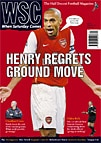 Jonathan Wilson, author of the acclaimed book Behind the Curtain, believe that eastern Europe’s hooliganism problem is real but exaggerated and reflects society’s wider struggles in an era of change
Jonathan Wilson, author of the acclaimed book Behind the Curtain, believe that eastern Europe’s hooliganism problem is real but exaggerated and reflects society’s wider struggles in an era of change
In the late 1970s, fans of Spartak Moscow, clad in red and white, would rampage through city centres and daub their slogans on walls. This season, their ultras have held aloft a giant banner sponsored by a vodka company. Such is the triumph of capital in Russia.
This is a remarkable reversal. The truth may be that Spartak were no more put upon than any other Soviet team (Dinamo Minsk, for instance, insist Spartak cheated them out of second place in 1954, while in the Eighties Spartak were almost certainly as much involved in the manipulation of results as anybody else) but their self image was one of heroic opposition – and, in the context of Brezhnev’s USSR, their vandalism was a radical expression of that identity.
They were financed not by the army or the police but by the trades unions, and, to the romantically inclined Muscovite at least, to support them was to register your freedom of thought. If fans of a team so obsessed by its own independence are willing to take the corporate rouble, it is safe to assume that everybody is. But while there may be something distasteful about fans become walking billboards, it is better they do that than beat each other to death with metal bars.
It is difficult to know whether that ever happens. Eastern Europe has a bad reputation for hooliganism, as was demonstrated by the frequent scare-stories claiming the World Cup would be invaded by Polish thugs, and the websites of various ultra groups depict a world of almost constant rioting, but my own experience suggests their bark is rather worse than their bite.
That is partly down to numbers. In 2004 I went to the Budapest derby between Ferencvaros and Ujpest and, having read up on the Fradi and the Purple Hippos, as their ultra groups are respectively known, I was expecting something resembling a war zone. In 2003, after Ferencvaros lost the title with a final-day defeat to Debrecen, the Fradi invaded the pitch and beat the opposing coach Lazar Szentes so badly he ruptured a kidney, but there was no sign of such hostility against Ujpest. There were impressive banners and a hold-up when the Ferencvaros goalkeeper was pelted with missiles (mainly sandwiches), but there were only 4,500 fans there.
I’ve seen scuffles at numerous Polish league games and there is no doubt that Belgrade derbies and games between Hajduk Split and Dinamo Zagreb are tinderboxes, but, in seven years of covering eastern European football, the only significant violence I’ve seen was at the Spartak v CSKA derby in Moscow in 2002. “Hooligans have regular fixtures,” a Spartak fan told me. “We arrange a place and meet outside town. Last year there were 300 of us and 300 of CSKA and we won. It’s OK, there are rules – everything is organised now, with the internet. You can use fists or bottles, but no knives.”
Even he, though, admitted hooliganism is on the wane. “It’s getting more difficult these days,” he said, “because the police have started using undercover agents.” On the day of the match, there were 149 arrests, but that was at least in part because the game was played on the anniversary of Hitler’s birth and Moscow that day teemed not only with fans and police, but also with far-right demonstrators. The extreme right certainly is not in decline.
The former Yugoslavia is a little different because of the nationalist undercurrents at play, but in other post-Communist countries the ultra culture exists because football provides a sense of community and identity in a society undergoing rapid change. As the historian Tamas Krausz has argued, in Hungary (and by extension in other countries who have recently joined or are about to join the EU) as society becomes richer, there is a section who feel left behind. This, typically, is made up of working-class males who, frustrated and with little to lose, are drawn to a violent nihilism by which their own identity as, say, a Purple Hippo is expressed by opposition to fans of other clubs and anything perceived as “other”.
There has been a handful of attacks on black players in Poland, for instance, while MTK, supposedly the Jewish club of Budapest, are regularly the subject of anti-Semitic abuse. “When there are economic and other hardships there are two ways of dealing with it,” Alexander Brod of Moscow’s Human Rights Bureau said. “The first is to reflect, and the second is to look for an enemy and blame him for your problems. Unfortunately, Russia has chosen the second path.”
That is unpleasant, but even when it amounts to no more than empty sabre-rattling, it is hard to know what football can do about it. As the then FA secretary Ted Croker once pointed out to Margaret Thatcher, hooliganism is society’s problem.
From WSC 239 January 2007. What was happening this month